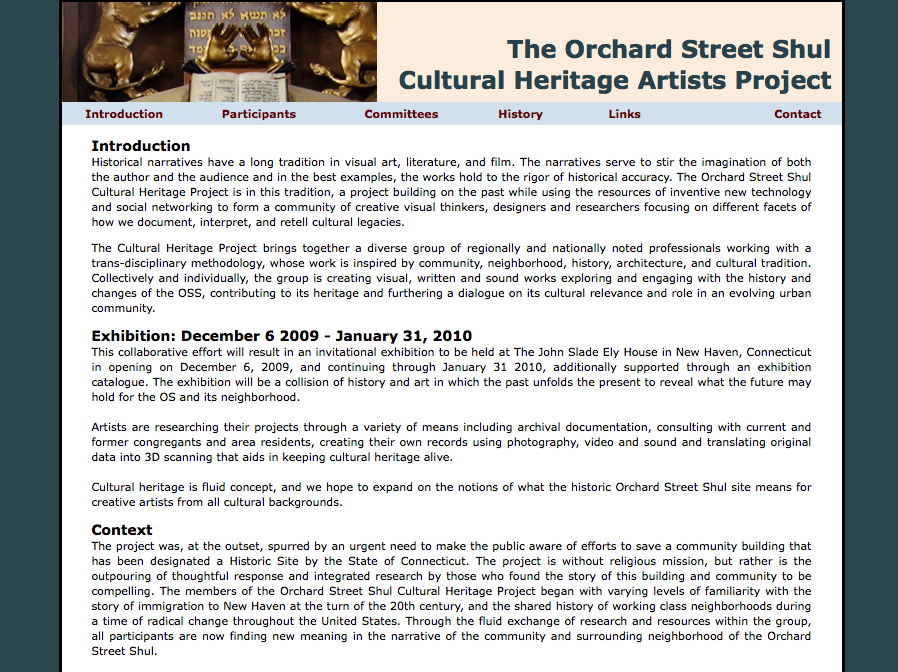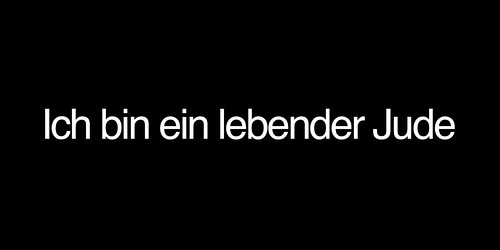I met Ben Schachter at the 2009 Conney Conference on Jewish Art: Performing Histories, Inscribing Jewishness, where coincidentally, we both presented Eruv themed works.In addition to making humorous Jewish themed conceptual art, Ben is a curator and is the man behind Tzit Tzit: Fiber Art and Jewish Identity. I have a few pieces from Hiddur Mitzvah included in the show.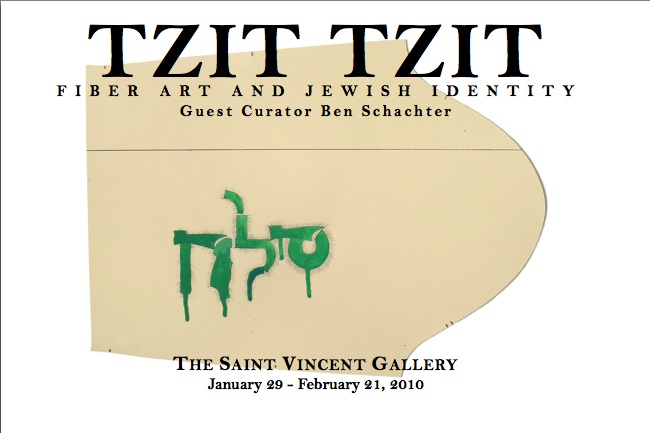 A special exhibit assembled by guest curator Ben Schachter, “Tzit Tzit: Fiber Art and Jewish Identity,” will open with a reception at The Saint Vincent Gallery in the Robert S. Carey Student Center at Saint Vincent College from 6 to 8:30 p.m. Thursday, January 28. Admission is free and open to the public.The exhibit will continue from Friday, January 29 through Sunday, February 21 during regular Gallery hours: 12 noon to 3 p.m. and 6:30 to 8:30 p.m. Tuesdays, Wednesdays and Thursdays; 12 noon to 3 p.m. Fridays, Saturdays and Sundays. The Gallery is closed on Mondays.Participating artists include Maya Escobar, Melanie Dankowicz, Carol Es, Leslie Golomb, Louise Silk and Shirah Apple.Ms. Silk will present a lecture, “Quilting and Spirituality,” at 6 p.m. Monday, February 9 in room 100 of Prep Hall.Mr. Schachter, associate professor of fine arts, will give a Gallery tour of the exhibition at 7:30 p.m. Tuesday, February 9.The exhibit was developed by Mr. Schachter. “I have been studying various aspects of Jewish art for the past three years and this exhibit is an outgrowth of that interest,” Mr. Schachter said. “The artists hail from Los Angeles, New York City, Kansas City, Illinois and Pittsburgh.”“Fiber art refers to any use of a cloth such as stitching or weaving,” he explained. “The title, Tzit Tzit, refers to the fringe on a prayer shawl, or tallis, worn by many Jews during prayer. While using thread, cloth, pattern making, stitching and other craft materials, each artists’ process creates a language derived from craft techniques that reinterprets the Old Testament, the oral law as written in the Talmud and personal histories. In so doing, both craft theory and Jewish Art are reinvigorated. I learned of these artists through Jewish art conferences I have attended, through exhibitions and through national awards. I think our students and our friends in the region will really enjoy seeing their work.”Ben Schachter is an artist whose work integrates conceptual art and Jewish law. He sees a connection between the rules artists have created to guide and limit their work and Jewish traditions. His work has been shown nationally and will be on exhibition at the Westmoreland Museum of Art in Greensburg concurrent with this exhibition. He holds an M.F.A. and M.S. degree from Pratt Institute and lives in Pittsburgh with his wife and two children.Carol Es paints images that powerfully scream of a life of hard labor. As a child she worked endless hours in a sweatshop with her family. Ms. Es' works are featured in numerous private and public collections, including the Getty Museum, Brooklyn Museum, UCLA Special Collections, the Jaffe Collection and Centre Georges Pompidou in Paris. She is also a two-time recipient of the ARC Grant from the Durfee Foundation and was recently awarded the prestigious Pollock-Krasner Fellowship.Maya Escobar’s work directly challenges gender roles and illustrates how Jewish tradition empowers women. Ms. Escobar received her master of fine arts degree from the Sam Fox School of Design & Visual Arts, Washington University in St. Louis, and her bachelor of fine arts degree from the School of the Art Institute of Chicago. She has exhibited work in Spain, Guatemala, United States, Germany and Venezuela.Melanie Dankowicz creates intricate papercut sculptures, marriage contracts, and wall art. An expansion of the medium, Dankowicz's three-dimensional forms are ephemeral lace-like paper structures, of elegant tracery that has inspired her recent metalwork. She draws inspiration from the countryside of Illinois, where she resides with Harry and their three children.Leslie Golomb exhibits her work nationally and internationally and is the recipient of numerous awards, including recognition from the National Endowment for the Arts, Pennsylvania Council on the Arts Individual Artists Fellowship Award and a State of the Art Award from the State Museum of Pennsylvania. Her work was recently included in the Three Rivers Arts Festival and Best of Pittsburgh Invitational. Ms. Golomb holds a bachelor in fine arts from Carnegie-Mellon University and a master of fine arts from the School of the Art Institute of Chicago. She served as founder and director of the American Jewish Museum of the Jewish Community Center of Greater Pittsburgh for nine years. She has returned to the studio producing prints and artists books.Louise Silk began her quest to acquire skills as a quilter after being inspired by an article in Ms. Magazine in 1971 about quilt making as a woman's art form. Over the past 30 years, her work has been included in Quilt National Biennial Exhibition of Contemporary Quilts as well as many private corporate collections such as USAirways, Paine Webber and PNC Bank. She is a certified Integrated Kabbalistic Healer. She is currently living and working from her loft in the South Side of Pittsburgh, Pennsylvania.Ms. Golumb and Ms. Silk collaborate and join their printmaking and fiber art into multilayered quilts, runners and tallisim. The images and techniques bring together American folk traditions and Jewish history in surprising ways. Ultimately the perspective of these five artists reinvigorates what Jewish Art is and can become.Shirah Apple received a master of fine arts degree from the Rinehart School of Sculpture at the Maryland Institute College of Art in 2006. She is a graduate of MICA’s post-baccalaureate certificate program and of Miami University, where she received a bachelor of science degree in business administration.Further information about the exhibition is available by contacting the Gallery at 724 805-2107, www.stvincent.edu/gallery.
A special exhibit assembled by guest curator Ben Schachter, “Tzit Tzit: Fiber Art and Jewish Identity,” will open with a reception at The Saint Vincent Gallery in the Robert S. Carey Student Center at Saint Vincent College from 6 to 8:30 p.m. Thursday, January 28. Admission is free and open to the public.The exhibit will continue from Friday, January 29 through Sunday, February 21 during regular Gallery hours: 12 noon to 3 p.m. and 6:30 to 8:30 p.m. Tuesdays, Wednesdays and Thursdays; 12 noon to 3 p.m. Fridays, Saturdays and Sundays. The Gallery is closed on Mondays.Participating artists include Maya Escobar, Melanie Dankowicz, Carol Es, Leslie Golomb, Louise Silk and Shirah Apple.Ms. Silk will present a lecture, “Quilting and Spirituality,” at 6 p.m. Monday, February 9 in room 100 of Prep Hall.Mr. Schachter, associate professor of fine arts, will give a Gallery tour of the exhibition at 7:30 p.m. Tuesday, February 9.The exhibit was developed by Mr. Schachter. “I have been studying various aspects of Jewish art for the past three years and this exhibit is an outgrowth of that interest,” Mr. Schachter said. “The artists hail from Los Angeles, New York City, Kansas City, Illinois and Pittsburgh.”“Fiber art refers to any use of a cloth such as stitching or weaving,” he explained. “The title, Tzit Tzit, refers to the fringe on a prayer shawl, or tallis, worn by many Jews during prayer. While using thread, cloth, pattern making, stitching and other craft materials, each artists’ process creates a language derived from craft techniques that reinterprets the Old Testament, the oral law as written in the Talmud and personal histories. In so doing, both craft theory and Jewish Art are reinvigorated. I learned of these artists through Jewish art conferences I have attended, through exhibitions and through national awards. I think our students and our friends in the region will really enjoy seeing their work.”Ben Schachter is an artist whose work integrates conceptual art and Jewish law. He sees a connection between the rules artists have created to guide and limit their work and Jewish traditions. His work has been shown nationally and will be on exhibition at the Westmoreland Museum of Art in Greensburg concurrent with this exhibition. He holds an M.F.A. and M.S. degree from Pratt Institute and lives in Pittsburgh with his wife and two children.Carol Es paints images that powerfully scream of a life of hard labor. As a child she worked endless hours in a sweatshop with her family. Ms. Es' works are featured in numerous private and public collections, including the Getty Museum, Brooklyn Museum, UCLA Special Collections, the Jaffe Collection and Centre Georges Pompidou in Paris. She is also a two-time recipient of the ARC Grant from the Durfee Foundation and was recently awarded the prestigious Pollock-Krasner Fellowship.Maya Escobar’s work directly challenges gender roles and illustrates how Jewish tradition empowers women. Ms. Escobar received her master of fine arts degree from the Sam Fox School of Design & Visual Arts, Washington University in St. Louis, and her bachelor of fine arts degree from the School of the Art Institute of Chicago. She has exhibited work in Spain, Guatemala, United States, Germany and Venezuela.Melanie Dankowicz creates intricate papercut sculptures, marriage contracts, and wall art. An expansion of the medium, Dankowicz's three-dimensional forms are ephemeral lace-like paper structures, of elegant tracery that has inspired her recent metalwork. She draws inspiration from the countryside of Illinois, where she resides with Harry and their three children.Leslie Golomb exhibits her work nationally and internationally and is the recipient of numerous awards, including recognition from the National Endowment for the Arts, Pennsylvania Council on the Arts Individual Artists Fellowship Award and a State of the Art Award from the State Museum of Pennsylvania. Her work was recently included in the Three Rivers Arts Festival and Best of Pittsburgh Invitational. Ms. Golomb holds a bachelor in fine arts from Carnegie-Mellon University and a master of fine arts from the School of the Art Institute of Chicago. She served as founder and director of the American Jewish Museum of the Jewish Community Center of Greater Pittsburgh for nine years. She has returned to the studio producing prints and artists books.Louise Silk began her quest to acquire skills as a quilter after being inspired by an article in Ms. Magazine in 1971 about quilt making as a woman's art form. Over the past 30 years, her work has been included in Quilt National Biennial Exhibition of Contemporary Quilts as well as many private corporate collections such as USAirways, Paine Webber and PNC Bank. She is a certified Integrated Kabbalistic Healer. She is currently living and working from her loft in the South Side of Pittsburgh, Pennsylvania.Ms. Golumb and Ms. Silk collaborate and join their printmaking and fiber art into multilayered quilts, runners and tallisim. The images and techniques bring together American folk traditions and Jewish history in surprising ways. Ultimately the perspective of these five artists reinvigorates what Jewish Art is and can become.Shirah Apple received a master of fine arts degree from the Rinehart School of Sculpture at the Maryland Institute College of Art in 2006. She is a graduate of MICA’s post-baccalaureate certificate program and of Miami University, where she received a bachelor of science degree in business administration.Further information about the exhibition is available by contacting the Gallery at 724 805-2107, www.stvincent.edu/gallery.
CHAP OPENING 12/6
Show opens 12/6. If you haven't seen it, check out guest post I did on MyJewishLearing.com about my father's and my piece in the show.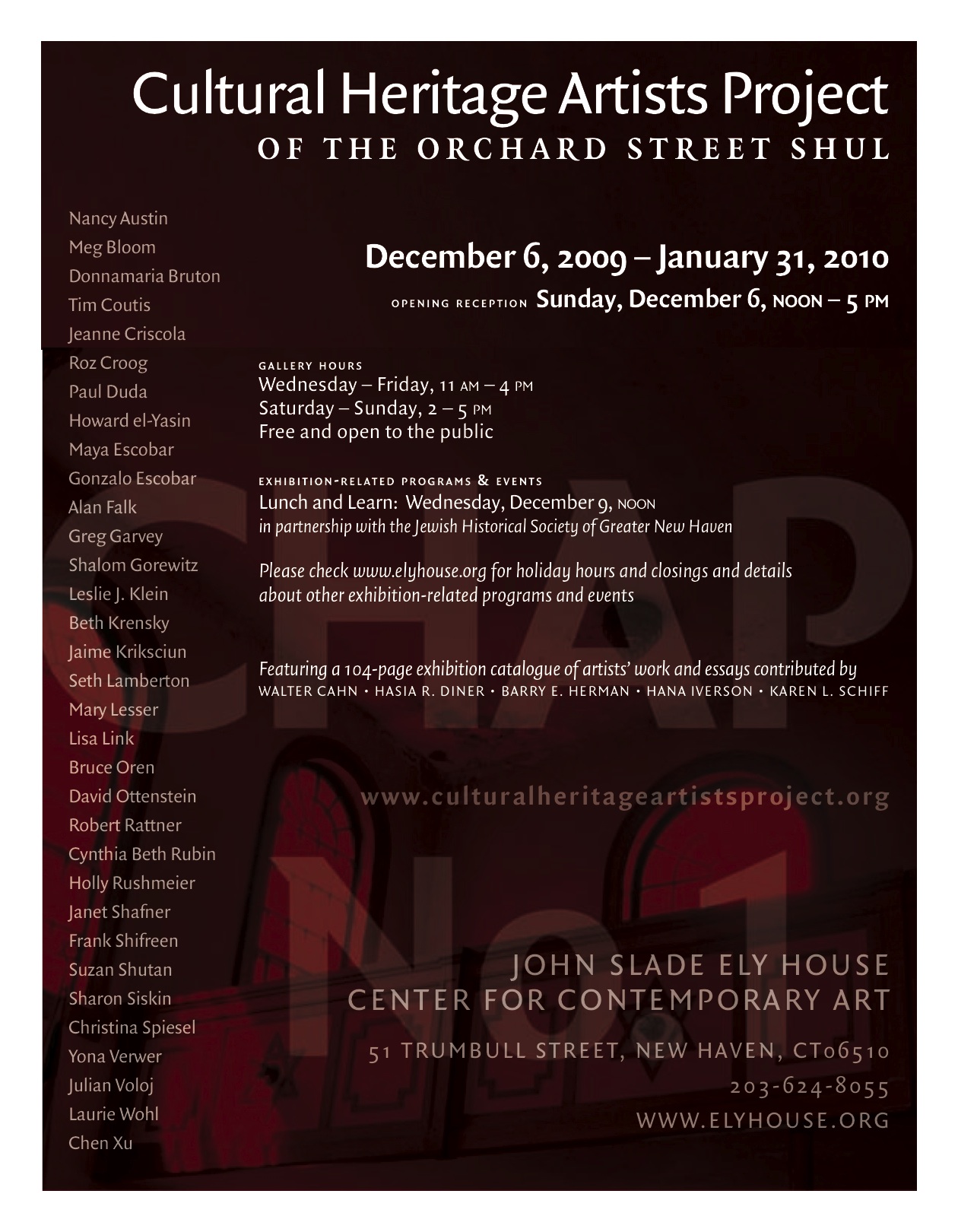
a guest post by seenoga
a guest post by seeNoga.
As you doggedly pursue, chase, and snap at the heels of your Self, you do so knowing there is no chance you will ever catch up. For each of us, throughout our individual lives, we will be ever distant from knowing our own selves. When a person pursues his or her Self in an aggressive, determined way, the resulting hyperactive sensibility allows for a greater adaptability and sensitivity. This flexibility can be useful in contemporary human life, but only to a certain extent. It is also due to the fast-paced nature of today’s engineered environments, that there is a strong tendency (especially among young people) to go to extreme lengths in order to sustain within their own lives the hyperactivity and intensity they witness in popular culture and media. Consider the called-for constant reachability via cell-phones and laptops, as well as many other forms of expedition in our ‘lived-in’ world. These accommodations range from aerodynamics to ATMs. As many workers in today’s professional world simultaneously lament and extol their parasitic relationships with a Blackberry or other such Pocket God, I, too, have at many times felt chained to my laptop (i.e. the Internet), fearing I would miss something absolutely critical. Unfortunately, the fact that missing anything important has not happened for the most part, hardly affects the worry and anxiety that it might happen.Yet still, it seems, this once motivating anxiety is becoming a repressed urge, one which is less and less a bother, the more my environment becomes one seamless, semi-omniscient “news” feed. On the evening of President Barack Obama’s Address to the Nation, Maya Escobar recorded “Obama Tweet: How a New Generation Gets Their Information.” In this video Escobar documented a particular event, an important cultural event, one which incidentally brought the use of Twitter to the fore in popular culture.[youtube= http://www.youtube.com/watch?v=359HwupsY1s]
Obama Tweet: How a New Generation Gets Their Information, 2008
I was with Escobar on this evening and was struck by the depth of her interaction with the digital realm. She was sitting in front of a T.V. broadcast of the speech, while she was also further mediating that media via her computer, on which she was following Twitter and CNN.com’s coverage of the event. Beyond all that, Escobar was creating her own real-time, indexical document of the event on television along with CNN and Twitter as instantaneous forms of annotations to the President's speech. Escobar was watching, sitting one more stage removed, behind the lens of a video camera. Because of the way in which she layered the television screen the computer screen and then the interface of any viewer's monitor, Escobar has effortlessly choreographed a multi-layered, engagement with the very most current of events. However, though I may have somewhat qualified and rationalized instant-communication tools, I still believe there must be a deliberate effort to complement those socially-prescribed media with other, independent forms of digital exchanges. While I do believe in the great social potential of our rapidly advancing communications media, my work seeks to push and pull on parts of these evolving global ‘informachines,’ in an effort to challenge the omnipresence of commercial media.[youtube=http://www.youtube.com/watch?v=d0ZvYQOp89I]
Look Out, 2008
That sort of layering of non-dimensional spaces is unique to the contemporary world, with the inception of digital technologies, and this collage-like aesthetic is of great interest to the work of Maya Escobar, as much as it is to my own. Although, unlike the deceptively referential works of my counter-part, in many of my works, I use and refer to popular media sources and specific Internet sites indirectly and rarely with any superficial visibility. It is with great deliberation and much hypothesizing that I curate my works in the manner in which I do. I intend my works to avoid specificity and leave wide-open their readings to a much more self-guided analysis by viewers. In the piece “Look Out,” the projected video came directly from YouTube. I simply cut off the last second of the original video, thus shortening it to 17 seconds. I then prepared it as a video-loop for its installation underneath a staircase at the Mildred Lane Kemper Art Museum. Because of its placement, where it fills a theretofore, unaddressed space, it is as though the rolling image is part of the museum structure itself. The particular clip, which I chose after viewing dozens of similarly tagged videos (‘storm,’ ‘tree,’ ‘willow,’ and ‘weeping’), was selected for very specific compositional reasons; reasons which are the very same principles of design taught to anyone working in commercial design or the visual arts: complimentary colors, rule of thirds, dynamic composition and varied textures, to name a few. Because of my focused selection process, this video, although created for very different (and unknown) reasons, still fits very well into the installation space as a deliberately designed, and potentially permanent use of what is otherwise a neglected space. The video became part of the stairwell. By existing within a predetermined, architectural frame, it became part of the space, as opposed to sitting on the surface as a painting does. This projection did not exist in the way that many (most) installations do: as obvious alterations or obtrusive interjections into a space. This work asserts itself as a physical part of the space, as the projector beams through from behind the scrim in the stairwell. It also assumes a living presence, as it reiterates itself, by many reflections and refractions, split and scattered, bouncing around the main hall of the museum. The video functioned as a decorative element but also an illusory window to an outside world, whereas, the space without that piece is simply a pane of glass that looks into the shadowy crotch of a stairwell. I do not mean every square inch should be taken up for some sort of visual activity or illusionary window. Simply, this work proposes how our constructed spaces, in this case a venue for art viewing, might be reinterpreted. Insofar as, a corner can conceivably become a window, as illusory and impermanent as my particular interpretation may be.
*NOESCO is seeNoga and maya escobar
Talking About Orchard Street

photo by Julian Voloj
Maya and Gonzalo Escobar create Talking about Orchard Street, a multi-sensory interactive installation that explores the generational transmission of Jewish life through dialog. The father-daughter duo traveled from Chicago to New Haven to conduct interviews with former members and friends of Orchard Street Shul and to record locals’ stories of growing up in New Haven during the 1920s and 30s. These stories of everyday life include tales of flirting on the front steps of the shul, eating herring and kichel, speaking Jewish, finding first jobs, going on first dates, learning bar mitzvah portions, and hearing (or having) loud conversations in the women’s section. In Talking about Orchard Street, visitors are invited to sit in comfortable armchairs, sample herring and kichel, listen to excerpts from interviews and engage in dialog with each other.click here for more information about the Orchard Street Shul Artist Cultural Heritage Project
Orchard Street Artist Cultural Heritage Project
My father and I participated in the Orchard Street Artist Cultural Heritage Project.
During the months of December 2009 and January 2010, The John Slade Ely House Center for Contemporary Art in New Haven, Connecticut will come alive with memories, recollections, and recreations of an important community heritage site, in an innovative group installation designed to both stimulate reflection on the legacies of past generations and engage the public in dreams for the future.The Orchard Street Shul Cultural Heritage Artists Project is an art exhibition, a history lesson, a point of cultural exchange, and meeting place for dreamers, both nostalgic and visionary. Artists, researchers, and scholars have joined together to celebrate an important historic New Haven landmark which was once central to the life of a large Jewish immigrant population in the Oak Street neighborhood.Urban changes in the last 50 years have all but erased evidence illustrating the importance of the Oak Street neighborhood in the lives of the newly arrived immigrants and migrants who populated much of the area now known as the "Oak Street Connector", Route 34. Where some see open space, or a new hospital, or a school, or a parking lot, others with longer memories see shops bustling with activity, voices shouting in Yiddish and Italian, sprinkled with a variety of accents from elsewhere, including near and distant regions within the USA.Contributions to the installation offer a range of approaches. Some artists researched the history of the Orchard Street Shul and its neighborhood, uncovering multiple stories of this community: stories of women working together to aid refugees, stories of hard-working fathers and mothers who dedicated themselves to making a better life for their children, and stories of teenagers who giggled and mingled on the steps of the Shul. Others built on their own experiences, reaching into their hearts to create depictions of the Shul that are evocative of deeper connections with history and community. Still others focused on the issues of urban renewal, making real the shifts in our urban landscape that are difficult to imagine as we visit the site today.Included in the Project are presentations by researchers from Yale University who developed innovative ways to document the building, including virtual reconstructions exploring new digital methods, ground-breaking research by computer scientists that promises to change the ways that cultural heritage sites will be documented in the future. Some contributing artists used this digital data in their creative work.The Orchard Street Shul Cultural Heritage Project is organized by Cynthia Beth Rubin, a New Haven based artist, in collaboration with participating artists and researchers: Nancy Austin, Meg Bloom, DonnaMaria Bruton, Jeanne Criscola, Roslyn Z. Croog, Linda Drazen, Paul Duda, Gonzalo Escobar, Maya Escobar, Alan Falk, Greg Garvey, Shalom Gorewitz, Jaime Kriksciun, Leslie J. Klein, Beth Krensky, Seth Lamberton, Mary Lesser, Lisa Link, David Ottenstein, Bruce Oren, Robert Rattner, Cynthia Beth Rubin, Holly Rushmeier, Janet Shafner, Frank Shifreen, Suzan Shutan, Sharon Siskin, Christina Spiesel, Yona Verwer, Julian Voloj, Laurie Wohl, Chen Xu, and Howard el-Yasin. The group includes artists from California, Florida, Utah, Missouri, Rhode Island, Massachusetts, and New York, who traveled to New Haven to contribute to the project alongside artists from the region.A Project Book is being published in conjunction with the exhibition, including essays by Haisia Diner, the eminent scholar of Jewish immigration history, Walter Cahn, renowned historian of art and and architecture, and Hana Iverson, known for her remarkable multi-media installation "View from the Balcony" that was instrumental in helping attract attention to the renovation project of the Eldridge Street Shul. The book will also feature photographs of the works in the exhibition and memories of the Orchard Street Shul, with commentary by Karen Schiff. The innovative book design is by Criscola Design.The Public is Invited to the Opening Reception for the Participating Artists, on Sunday, December 6, from 12:00 Noon to 5:00 pm. To set the mood for the launch of “The Orchard Street Shul Artists Cultural Heritage Project”, the Joseph Slifka Center for Jewish Life at Yale for Jewish Life at Yale will host a Jazz jam session on December 5 at 7:30, celebrating the swing dance music of 1924 and beyond, when the cornerstone of this Synagogue was put in place in a ceremony attended by Mayor Fitzgerald and much of the entire New Haven community.The John Slade Ely House Center for Contemporary Art is open W-F, 11:00 am to 4:00 pm, and weekends 2:00 pm to 5:00 pm. Schools and other organizations who would like to arrange a group visit outside of regular hours may do so by sending an email to: [email protected].
Berlin's Eruv Video
[youtube=http://www.youtube.com/watch?v=bGjJhIFUNGA][youtube=http://www.youtube.com/watch?v=CycyYiY933A][youtube=http://www.youtube.com/watch?v=yCM4rrhbj5U]click here to visit website
Berlin's Eruv at the 2009 Conney Conference on Jewish Art
I will be presenting Berlin's Eruv at the 2009 Conney Conference: Performing Histories, Inscribing Jewishness at University of Wisconsin Madison. Berlin’s Eruv is a conceptual project that addresses the assumed non-presence of Jews in Germany. Berlin does not actually have an eruv. There is however, an active Jewish community, one that is frequently overshadowed by the city's prominent monuments and memorials commemorating Jewish life (death). Berlin's Eruv weaves together voices from Berlin's Jewish community in an attempt to construct a metaphorical eruv representative of a living Jewish Community. Just as the eruv exists in the minds of the people who abide by it, Berlin’s Eruv manifests itself through the conversations surrounding the idea of the piece.*****I will be showing Berlin's Eruv at 2009 MFA Thesis Exhibition, opening May 8th at the Kemper Art Museum.
Berlin’s Eruv is a conceptual project that addresses the assumed non-presence of Jews in Germany. Berlin does not actually have an eruv. There is however, an active Jewish community, one that is frequently overshadowed by the city's prominent monuments and memorials commemorating Jewish life (death). Berlin's Eruv weaves together voices from Berlin's Jewish community in an attempt to construct a metaphorical eruv representative of a living Jewish Community. Just as the eruv exists in the minds of the people who abide by it, Berlin’s Eruv manifests itself through the conversations surrounding the idea of the piece.*****I will be showing Berlin's Eruv at 2009 MFA Thesis Exhibition, opening May 8th at the Kemper Art Museum.
Washington University in St. Louis MFA Open Studios
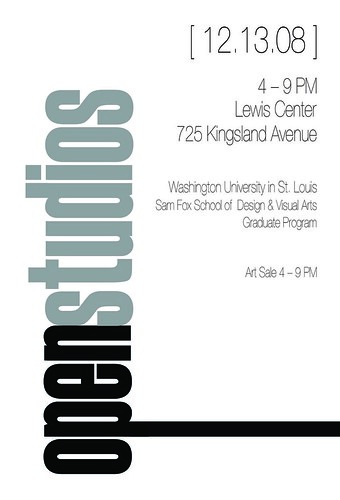 Washington University Graduate Open Studios and Art Sale Saturday, December 13th, 2008 Open Studios: 4-9 p.m. Lewis Center725 Kingsland_____________________________________________________________________Washington University MFA students are pleased to announce our Fall 2008 Open Studios and Art Sale, featuring work by more than 40 innovative young artists working in painting, printmaking, photography, sculpture, combined media, installation and video.From 4-9 our studios will be open to the public and artists will be present to answer questions and interact with visitors. This event presents a unique opportunity to experience the work of emerging artists outside the traditional gallery setting. The event will be accompanied by an art sale from 4-9:00 pm.The art sale will take place on the third floor of the MFA Building and will feature original works by MFA students. Payments may be made in cash, or by check with ID only. Proceeds will benefit the Washington MFA Student Organization and will be put towards the growth and development of the MFA program as well as to the individual artist.The Graduate Program has been flourishing at Washington University. Housed in the distinctive Lewis Center in the heart of University City, MFA students and faculty interact in a collaborative, organic setting, creating a program that is always evolving and pushing the boundaries of contemporary artistic practice. Please join us for this unique event.
Washington University Graduate Open Studios and Art Sale Saturday, December 13th, 2008 Open Studios: 4-9 p.m. Lewis Center725 Kingsland_____________________________________________________________________Washington University MFA students are pleased to announce our Fall 2008 Open Studios and Art Sale, featuring work by more than 40 innovative young artists working in painting, printmaking, photography, sculpture, combined media, installation and video.From 4-9 our studios will be open to the public and artists will be present to answer questions and interact with visitors. This event presents a unique opportunity to experience the work of emerging artists outside the traditional gallery setting. The event will be accompanied by an art sale from 4-9:00 pm.The art sale will take place on the third floor of the MFA Building and will feature original works by MFA students. Payments may be made in cash, or by check with ID only. Proceeds will benefit the Washington MFA Student Organization and will be put towards the growth and development of the MFA program as well as to the individual artist.The Graduate Program has been flourishing at Washington University. Housed in the distinctive Lewis Center in the heart of University City, MFA students and faculty interact in a collaborative, organic setting, creating a program that is always evolving and pushing the boundaries of contemporary artistic practice. Please join us for this unique event.
Berlin's Eruv
ARTE ≠ VIDA: ACTIONS BY ARTISTS OF THE AMERICAS
Last weekend Carianne and I went to NY for the 2008 Whitney Biennial. As we expected from a survey of Contemporary American Art, not everything in the exhibition appealed to us. However neither of us was disappointed because we were not expecting to be unilaterally wowed. Upon leaving the Whitney, we got into an in-depth discussion about individuals' preconceived expectations, and the role they play in the determining interaction/interpretation/enjoyment, with actual works of art. Soon after this conversation, I was put to the test. As any young MFA student (traveling to New York) who has any hopes of some day having a career, Carianne and I were preparing to leave our hotel, to visit the elusive Chelsea Galleries, when I came upon an announcement for a show at El Museo Del Barrio, ARTE ≠ VIDA: ACTIONS BY ARTISTS OF THE AMERICAS
“Arte no es vida” surveys, for the first time ever, the vast array of performative actions created over the last half century by Latino artists in the United States and by artists working in Puerto Rico, the Dominican Republic, Cuba, Mexico, Central and South America.
Many of the works included in Arte ≠ Vida have subtle or overt political contexts and content: military dictatorships, civil wars, disappearances, invasions, brutality, censorship, civil rights struggles, immigration issues, discrimination, and economic woes have troubled the artists’ homelands continuously over the past four decades and therefore have infiltrated their consciousness. According to curator Deborah Cullen, “the exhibition title challenges the commonplace idea that art is equivalent to life, and life is art. What is proposed through these many works is that while art affirms and celebrates life with a regenerative force, and sharpens and provokes our critical senses, artistic actions which address inequalities and conflict are not equivalent to real life endured under actual repression.”
Over 75 artists and collectives are represented in Arte ≠ Vida, including ASCO, Tania Bruguera, CADA, Lygia Clark, Papo Colo, Juan Downey, Rafael Ferrer, Guillermo Gómez-Peña, Alberto Greco, Alfredo Jaar, Tony Labat, Ana Mendieta, Marta Minujin, Raphael Montañez-Ortiz, Hélio Oiticica, Tunga and contemporary practitioners including Francis Alÿs, Coco Fusco, Regina José Galindo, Teresa Margolles and Santiago Sierra. The exhibition is arranged in four major sections, in which each decade is represented by several specific themes that often cross national boundaries. 1960-1970 looks at select precursors, signaling, destructivism and neoconcretismo; 1970-1980 considers political protest, class struggle, happenings, land/body relationships and border crossing; 1980-1990 focuses upon anti-dictatorship protest and dreamscapes; and 1990-2000 references the Quincentenary, multiculturalism, postmodernism and endurance. An additional section highlights interventions that artists have carried out on television over the past 20 years. In these chronological, thematic groupings, viewers will be able to explore the interconnections among various artists’ actions as well as the surges of activities triggered by specific events in certain countries.
I didn't know what to do. This sounded to good to be true, but we also knew we were supposed to visit the Chelsea Galleries. I considered just buying the catalogue to the exhibition and skipping the show. I don't know if it was faith or instinct that got us there, but I can say with out any doubt in my mind that this was single handedly the best exhibition I have ever attended.
"¿Quién puede olvidar las huellas?," Regina Galindo. 2003.
Galindo walking through the streets of downtown Guatemala City, wetting her feet in a blood-filled bucket, and leaving a path of footprints from the Constitutional Court building to the Presidential Palace, where she was welcomed by a police battalion. The Court had just validated former dictator Efraín Ríos Montt, the country’s foremost author of genocide, as a presidential candidate.
[youtube="http://uk.youtube.com/watch?v=D46p71QdCTc"]

Oscar Bony (1941-2002) hired a working-class family at twice their going wage to pose in a Buenos Aires gallery as a living work of art
[youtube=http://uk.youtube.com/watch?v=8N5xbLtokZY]
"Arte Reembolso/Art Rebate" by Elizabeth Sisco, Louis Hock and David Avalos. 1993.


[...] "The current economic recession has been debilitating for many artists regardless of the content of their work. Since this climate is characterized by a particular hostility toward controversial art, it is especially significant that Elizabeth Sisco. Louis Hock. and David Avalos have maintained a reputation for causing trouble in San Diego. Their collaborative public art projects receive scandalous reports in local and national news media and are often used as examples of the National Endowment for the Art' inadequate standards of quality. Their most current collaborative project Art Rebate (1993) refunded $10 bills to 450 undocumented workers along the San Diego, California/Mexico border. It was commissioned by the Museum of Contemporary Art, San Diego and Centro Cultural de la Raza as part of the "La Frontera/The Border" exhibition. In response to recent attention to border relations due to NAFTA and other government policies, the artists wished to refute the popular misconception that undocumented Mexican workers do not pay taxes as well as demonstrate. albeit with a small symbolic gesture, their appreciation of the undocumented as valued members of Western states, communities. Furthermore, I believe their work has significant implications for undocumented workers from other nations, residing in other regions of the United States - Caribbean workers in Florida and New York City, for example. If the communities in which the undocumented workers from these areas work and reside could also acknowledge their common contributions, in the form of taxes among other things, then perhaps we as a society could also begin to address the crimes inflicted upon these groups and apply our democratic notions of human rights to those within our national borders. [...]
"The projects are clearly controversial. That's not an accident. It's not as if someone latches onto the projects and holds them up as problematic. We intend to create something that is provocative and engenders a public discussion. It is public art, not art in the public. The work is defined by its performance in the community. The public discussion is crucial to the project. In order to begin a discussion we initiate an action - for example, a bus poster or a $10 rebate - that starts the ball rolling. We definitely aim to draw in the broadest spectrum of people, including those in power for the discussion. Obviously the media is not a neutral mechanism for communicating the events that unfold during the projects: it has an agenda that shapes its participation in the discussion. For example, much of the language used to describe Art Rebate in the press was the same inflammatory rhetoric promoted and laid out by the politicians who had given a profile of blame to the undocumented. Similarly, the press had a hard time imagining, and therefore was unable to fairly convey, the undocumented as taxpayers. The press was invited to experience the act of rebating these signed $10 bills. They were encouraged to ask the opinion of undocumented workers concerning their status as taxpayers, but the responses failed to appear prominently in the news media. The media coverage was not a means of evaluating the project but rather a component of the project. Their viewpoints describe a conceptual social space in which they situate the taxpayer and the undocumented in different realms."
"The Parthenon of Books/Homage to Democracy, Buenos Aires," Marta Minujín. 1983.
In December 1983 the Argentine Conceptual artist Marta Minujin and a group of helpers spent 17 days building a full-scale model of the Parthenon in a public park in Buenos Aires, Roberta Smith writes. Except for a metal scaffolding, it was made almost entirely of books wrapped in plastic. All the books had been banned by one of the most oppressive juntas in the country’s history, which was just being dismantled after Argentina’s first democratic election in a decade. “The Parthenon of Books/Homage to Democracy,” as Ms. Minujin’s work was titled, stood for about three weeks. Then the public was allowed to disassemble the piece and keep the books.
partenon de libros marta minujinAvenida 9 deJulio y Avenida Santa Fe. Buenos Aires. Argentina. Concebida como un monumento a la democracia y a la educación por el arte, Partenón constaba una estructura metálica, réplica del partenón, recubierta con prohibidos durante la dictadura militar.


[...]In a similar fashion to the live human spectacles of the past, Fusco and Gomez-Peña performed the role of cultural "other" for their museum audiences. While on display the artists' "traditional" daily rituals ranged from sewing voodoo dolls, to lifting weights to watching television to working on laptop computers. During feeding time museum guards passed bananas to the artists and when the couple needed to use the bathroom they were escorted from their cage on leashes. For a small donation, Fusco could be persuaded to dance (to rap music) or both performers would pose for Polaroids. Signs assured the visitors that the Guatinauis "were a jovial and playful race, with a genuine affection for the debris of Western industrialized popular culture . . . Both of the Guatinauis are quite affectionate in the cage, seemingly uninhibited in their physical and sexual habits despite the presence of an audience." Two museum guards from local institutions stood by the cage and supplied the inquisitive visitor with additional (equally fictitious) information about the couple. An encyclopedic-looking map of the Gulf of Mexico, for instance, showed the supposed geographic location of their island. Using maps, guides, and the ambiguous museum jargon, Fusco and Gomez-Peña employed the common vocabulary of the museum world to stage their own display[...]
"Construction of a Traditional Rural Oven,'' Víctor Grippo y Jorge Gamarra. 1972.
CONSTRUCCION DE UN HORNO POPULAR PARA HACER PAN
Intención: Trasladar un objeto conocido en un determinado entorno y por determinada gente, a otro entorno transitado por otro tipo de personas.Objeto: Revalorizar un elemento de uso cotidiano, lo que implica, además del aspecto constructivo escultórico, una actitud.Acción:a) Construcción del Hornob) Fabricación del Panc) Partición del Pan.Resultante pedagógica: Describir el proceso de construcción del Horno y de la fabricación del Pan. Distribuir una hoja. Será posible la participación del público mediante un intercambio de información.
"Untitled (Body Tracks),'' Ana Mendieta. 1974.

abidin travels
 (above)Willie Cole, The Difference between Black and White,2005-6. Shoes, wood, metal, screws, and staples, 85 x 16".
(above)Willie Cole, The Difference between Black and White,2005-6. Shoes, wood, metal, screws, and staples, 85 x 16".
ST. LOUIS, MO - War and disaster have profoundly shaped the opening years of the 21st century. In the United States and abroad, acts of violence and terrorism as well as natural catastrophes have resulted in large-scale destruction and displacement affecting the lives of millions. In February, the Mildred Lane Kemper Art Museum at Washington University in St. Louis will present On the Margins, an exhibition exploring the impact of war and disaster through the work of a diverse range of contemporary artists. Curated by Carmon Colangelo — a nationally known printmaker as well as dean of the university's Sam Fox School of Design & Visual Arts — the exhibition will showcase more than a dozen works, ranging from prints and photographs to video and large-scale installations, by ten artists from around the world. Several installations play against traditional approaches to war memorial. For example, Fallen (2004-ongoing), by the American artist Jane Hammond, comprises a large field of brightly colored leaves, each bearing the name of a soldier killed in Iraq. Similarly elegiac is Metal Jacket (1992/2001), by South Korea's Do-Ho Suh, which consists of 3000 dog tags stitched to the liner of a U.S. military jacket. Abidin Travels: Welcome to Baghdad (2006), an interactive video installation by the Iraqi expatriate Adel Abidin, allows viewers to become virtual tourists amidst the wreckage of his native Baghdad.
In conjunction with the exhibition MFA candidates Carianne Noga, Dan Solberg, Erica Millspaugh and I assumed the role of travel agents assisting museum visitors in arranging their virtual flight Baghdad aboard a B52.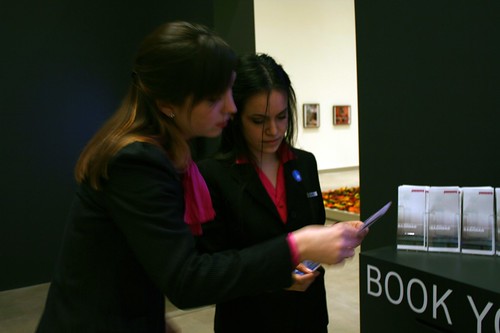
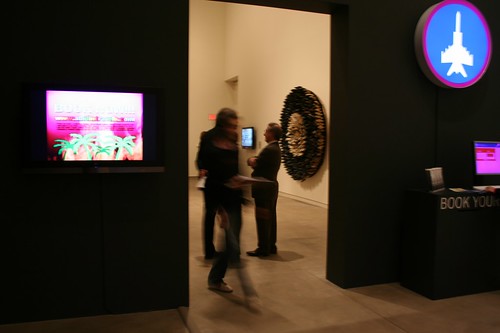

your responses
RELATED POSTSGallery OpeningNext Phase of Acciones PlasticasVideo ResponsesHow does it feel to be called a JAP? Now I am asking you to participate. Hopefully viewing these images has caused you to question if and when similar stereotypes have been applied to you or those around you. Please take the time to share your experiences by clicking on any of the dolls to submit your response.



 I have included a section with guiding questions. If you have more you would like to submit post them herePlease feel free but not limited to answering the following questions regarding each doll:
I have included a section with guiding questions. If you have more you would like to submit post them herePlease feel free but not limited to answering the following questions regarding each doll:
Is there any truth to this description?Are all of these things negative?What is the origin of this stereotype?What is a _________ really like?What does this stereotype leave unsaid?
[youtube=http://www.youtube.com/watch?v=wBkROAn7efM][youtube=http://www.youtube.com/watch?v=-kohK1qimhI][youtube=http://www.youtube.com/watch?v=4Zsr4NmtG0I]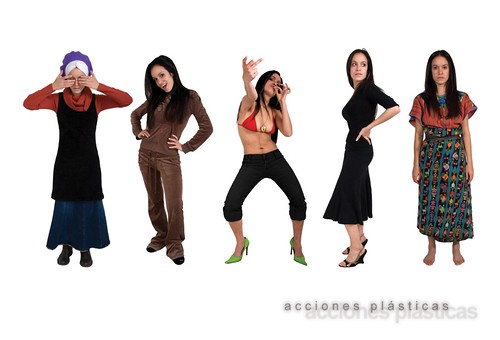
Producto? Inc
UPDATEBraulio was featured on artnet.com Artist Alfi Rolón performing as part of Braulio Espinosa Castillo’s "Artistas de Hoy"
Artist Alfi Rolón performing as part of Braulio Espinosa Castillo’s "Artistas de Hoy"
Circa ’07 also featured a row of smaller booths housing individual projects by invited artists. One of the most popular was "Artistas de Hoy," a project stage-managed by Braulio Espinosa Castillo of Producto? Inc., for which he somehow convinced 40 artists to pose in a glass display case alongside a video of their artwork. The combination was a perfect gambit. Not only were the videos illuminating, but fair visitors clearly were enchanted by the opportunity to stare at real artists standing in a booth.
Producto? Inc. es una propuesta que nace de la reflexión en torno a la condición "natural" del individuo como producto mercantil. Con la dirección de Braulio Espinosa Castillo y la colaboración incondicional de familiares, amigos, colegas artistas y auspiciadores.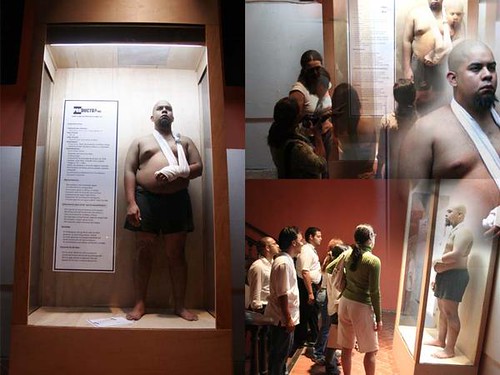
El proceso de cosificación que produce la sociedad de consumo a la que nos enfrentamos a diario no se limita solo a la materia no viviente y no pensante, sino también a los seres humanos: mercaderes y consumidores. Siempre el hombre ha puesto algún tipo de valor sobre la materia, sea viva o no. Un producto mercantil es una cosa producida con la finalidad de la venta. En el contexto actual de vida somos un producto mercantil, primero por que somos una cosa producida. Producida por el hogar, la iglesia, las escuelas, la universidad, los trabajos. Segundo, mientras no exista otro sistema económico, todos cambiaremos dinero por nuestro servicio; trabajo y conocimiento. El salario mide el precio del trabajo, que a fin de cuenta, define el valor material del trabajador, el producto. En algunos países el acto es aún más literal, cuando se venden esclavos, niños y órganos humanos.
En CIRCA 07 estarán participando 40 colegas artistas, cada uno con su propuesta individual de ellos mismos como producto mercantil. Durante 25 minutos estarán en exhibición, en instalación-performace.
